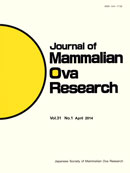31 巻, 1 号
選択された号の論文の9件中1~9を表示しています
- |<
- <
- 1
- >
- >|
Mini Symposium
-
2014 年31 巻1 号 p. 1
発行日: 2014年
公開日: 2014/05/31
PDF形式でダウンロード (294K) -
2014 年31 巻1 号 p. 2-11
発行日: 2014年
公開日: 2014/05/31
PDF形式でダウンロード (1657K) -
2014 年31 巻1 号 p. 12-16
発行日: 2014年
公開日: 2014/05/31
PDF形式でダウンロード (989K) -
2014 年31 巻1 号 p. 17-22
発行日: 2014年
公開日: 2014/05/31
PDF形式でダウンロード (629K) -
2014 年31 巻1 号 p. 23-30
発行日: 2014年
公開日: 2014/05/31
PDF形式でダウンロード (865K)
Originals
-
2014 年31 巻1 号 p. 31-39
発行日: 2014年
公開日: 2014/05/31
PDF形式でダウンロード (1056K) -
2014 年31 巻1 号 p. 40-44
発行日: 2014年
公開日: 2014/05/31
PDF形式でダウンロード (551K) -
2014 年31 巻1 号 p. 45-51
発行日: 2014年
公開日: 2014/05/31
PDF形式でダウンロード (835K)
Case Report
-
2014 年31 巻1 号 p. 52-56
発行日: 2014年
公開日: 2014/05/31
PDF形式でダウンロード (641K)
- |<
- <
- 1
- >
- >|
